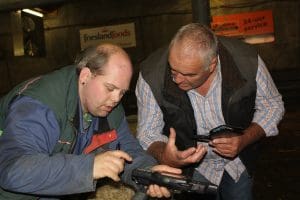
Horsham saleyard manager Paul Christopher discusses scanning with a Dutch livestock mart worker.
VICTORIAN saleyards will need more time to trial electronic sheep tagging hardware and software than has been allowed by the State Government, according to Horsham Regional Livestock Exchange manager Paul Christopher.
Agriculture Victoria wants scanning of electronically tagged sheep and goats to start from July 1 2017 in saleyards, abattoirs, and knackeries, uploading the information to the National Livestock Identification System database.
From March 31, 2018, all electronically tagged sheep and goats must be scanned in saleyards and the information uploaded to the NLIS database.
But after returning from a tour through England and the Netherlands this week investigating livestock EID systems, Mr Christopher believes Victorian saleyards are going to need more time to trial EID hardware and software.
“It is going to be fairly hard to do that in the next two months – we need to push it another 2-3 months to get these trials done.
“I think as managers of Victorian saleyards we need to get around to all these trials and have a look at them all.”
“We won’t want to waste the money.”
Pen vs race scanning
Mr Christopher said he had not seen anything in the UK he would be implementing at Horsham, with most sheep in English markets being either scanned in pens or in races coming out of selling rings.
He was concerned with the OH&S implications of scanning sheep and lambs in pens with hand-held wands.
“Over time there might be a problem with someone getting knocked down or hurt.
“That’s my concern, I’m not saying it can’t be done.”
The tour did not see any race readers being used in loading or unloading ramps.
“I was hoping that the race scanners would better and more fool-proof, but I think the race system, being used in the United Kingdom is not being used to its full potential.”
He said some of the UK markets using race readers were not checking on “non-readers”.
“It doesn’t seem to be a big priority of theirs, which it has to be in Australia, because we have to get to our 98 percent.”
Mr Christopher said it was hard in the UK to get right information on what percentage of sheep with tags were being read, with some sheep not having tags.
But he said trials with similar covered race readers at Horsham had yielded some “fairly correct read rates.”
“I think what has come out of the tour is that I know that scanners work and we’ve seen some software that the company’s say will work – we need to do trials with the different scanners and software providers.”
“And we’ve just got to work out which one is going to work for us as far as EID is concerned.”
Race readers will work
Mr Christopher was fairly confident that the covered race readers will work in the Horsham saleyards, but was not sure how they would be implemented yet.
A two-lane open race reader demonstrated by Shearwell Data was “good”, but he did not know whether the lambs had effectively been “trained” by being put through several times.
“They were getting 100 percent with that and I like the concept.”
“We need trials, but I’m staying positive, I think it will work, we’ve just got to find the right system for us now.”
The tour also saw Aleis race readers operating post-sale in ring-selling systems
Mr Christopher believed the available EID software would also work in Victorian saleyards.
“But it is going to be how hard the implementation is and how hard it is for any person to be able to use it – not only myself or agents, but I would like to think it would be that easy that a sheep cocky or a truck driver would be able to use it with the right information.”
Mr Christopher said for “true traceability” he believed two scans might be needed, before and after sale. He said a single scan could work as well, but he was concerned about sheep jumping out of pens or mistakes moving sheep after sales leading to scanning discrepancies.
Victoria’s transition package is a plus
Mr Christopher said the Victorian industry was lucky its EID transition infrastructure was being funded through the state government $17 million package.
“The UK (industry) was made to do it and there was no funding whatsoever, although the UK farmers do get subsidies.”
The UK sheep EID system also still had a paper-based component to their EID system with associated staff.
“While you’ve got a paper-based system you are still going to have trouble.”



HAVE YOUR SAY